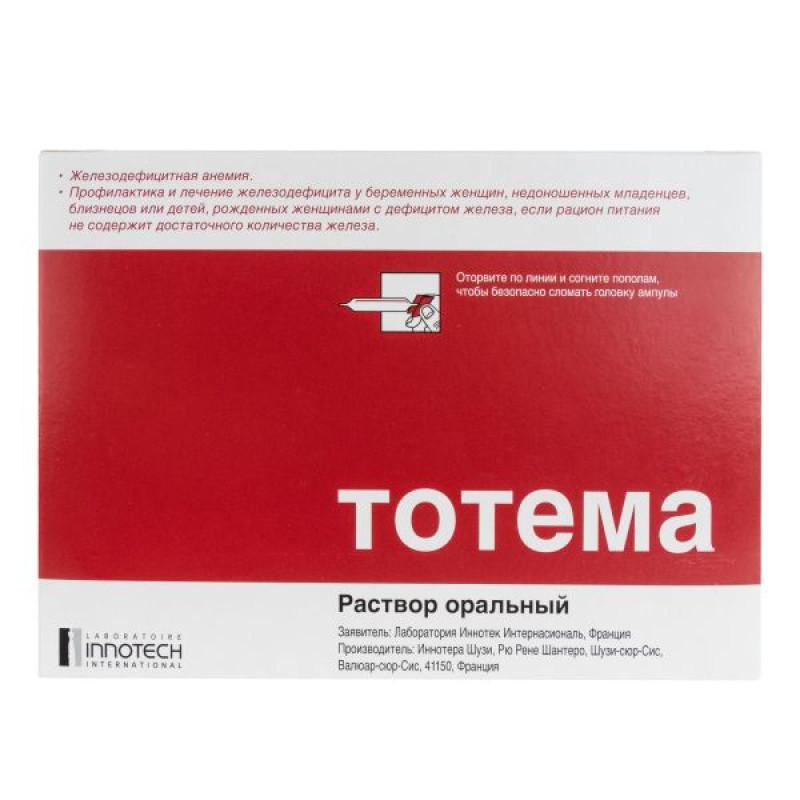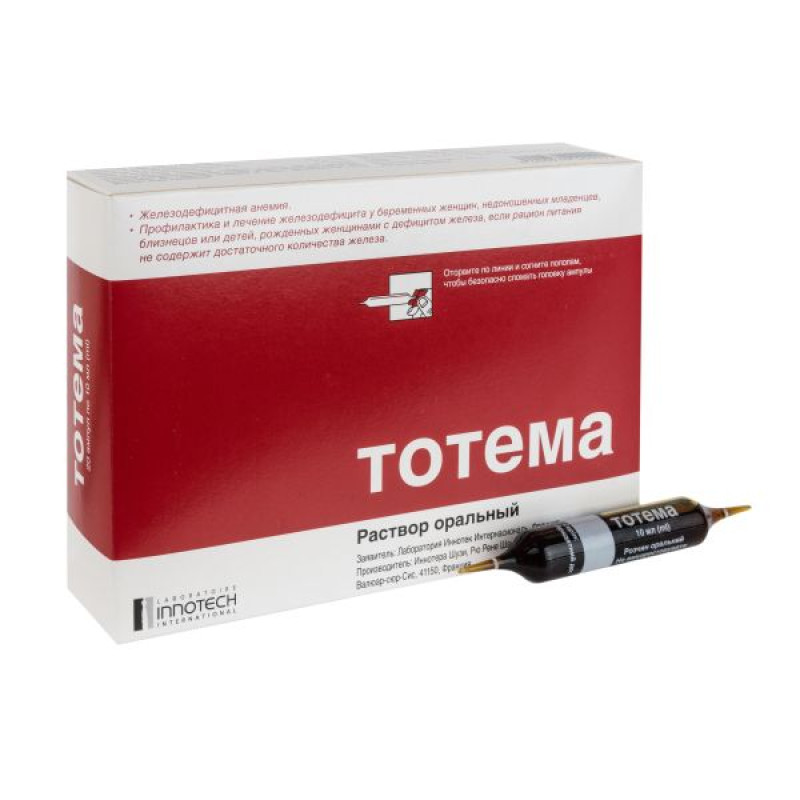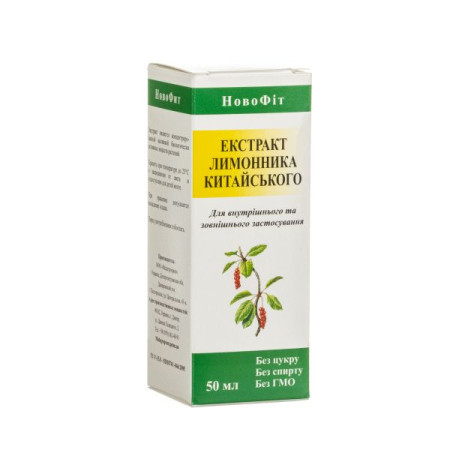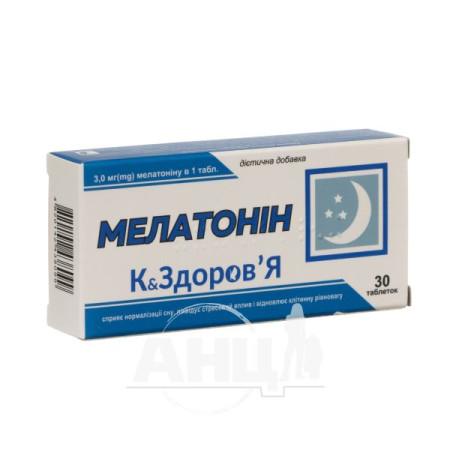Totema oral solution ampoule 10 ml No. 20

Instructions for Totema oral solution ampoule 10 ml No. 20
Composition
active ingredients: iron (in the form of ferrous gluconate hydrate); manganese (in the form of manganese gluconate); copper (in the form of copper gluconate);
1 ampoule (10 ml) contains iron (as ferrous gluconate hydrate) 50 mg; manganese (as manganese gluconate) 1.33 mg; copper (as copper gluconate) 0.7 mg;
excipients: glycerin, glucose solution, sucrose, citric acid, sodium citrate, sodium benzoate (E 211), polysorbate 80, ammonia caramel (E 150c)*, Tutti Frutti flavoring**, purified water.
*Ammonia caramel composition (E 150c)*: glucose, ammonium hydroxide.
**Ingredients of Tutti Frutti flavoring: isoamyl acetate, isoamyl butyrate, benzaldehyde, ethyl methylphenyl glycidate, gamma-undecalactone, ethyl vanillin, ethanol, water.
Dosage form
Oral solution.
Main physical and chemical properties: clear liquid of dark brown color. The presence of fine sediment is possible.
Pharmacotherapeutic group
Antianemic agents. Iron preparations, various combinations.
ATX code B03A E10.
Pharmacological properties
Pharmacodynamics
A combined preparation containing essential trace elements – iron (II), copper and manganese, which are necessary to maintain the process of hematopoiesis.
Mechanism of action
Iron is an essential trace element that plays a key role in many physiological processes, such as oxygen transport, ATP production, DNA synthesis, and electron transport.
Iron is the central atom of heme groups that make up the structure of hemoglobin, and is therefore essential for erythropoiesis.
Iron supplements help eliminate iron deficiency in the body and prevent its development in cases of increased iron needs or insufficient iron stores.
Pharmacokinetics
Absorption
Iron absorption is an active process that occurs primarily in the duodenum and proximal small intestine. Absorption increases as body iron stores decrease.
Copper may positively influence iron transport in enterocytes. Iron absorption may be affected by the simultaneous consumption of certain foods, beverages or the simultaneous administration of certain medicinal products (see sections “Special instructions for use” and “Interaction with other medicinal products and other types of interactions”).
Distribution
In the body, iron is stored mainly in the bone marrow (erythroblasts) and erythrocytes. Iron in the form of ferritin is stored in the liver, spleen and bone marrow. Iron is transported in the bloodstream by transferrin, mainly to the bone marrow, from where it is incorporated into hemoglobin.
Metabolism
Iron, copper, and manganese are metal ions that are not metabolized by the liver.
Breeding
The average iron excretion rate in healthy individuals is estimated to be approximately 1 mg/day.
The main routes of excretion are the gastrointestinal tract (enterocyte detachment, heme breakdown due to erythrocyte extravasation), the genitourinary tract, and the skin.
The main route of excretion of manganese and copper is through bile.
Indication
Treatment of iron deficiency anemia in adults, children and infants.
Prevention and treatment of iron deficiency in pregnant women, premature infants, twins, or children born to iron-deficient women if the diet does not contain enough iron.
Contraindication
Hypersensitivity to the active substances or to any of the excipients.
Excess iron in the body due to increased intestinal absorption or altered iron metabolism (e.g., hemochromatosis, thalassemia, refractory anemia, aplastic anemia, sideroblastic anemia) or due to excessive parenteral administration (e.g., repeated or prolonged blood transfusions).
Anemias not associated with iron deficiency (e.g., hemolytic anemia, megaloblastic anemia, anemia of inflammation).
Wilson's disease.
Interaction with other medicinal products and other types of interactions
Combinations not recommended for use
+ Iron (salts) (injectable):
Lipothymia (pre-unconscious state) or even shock due to rapid release of iron from its complex form and saturation of transferrin.
Combinations to be used with caution
+ Cyclins (oral use):
Reduced absorption of cyclins and iron in the gastrointestinal tract.
Iron salts and cyclins should be taken separately (if possible with an interval of more than 2 hours).
+ Fluoroquinolones:
Reduced absorption of fluoroquinolones in the gastrointestinal tract.
Iron salts and fluoroquinolones should be taken separately (if possible with an interval of more than 2 hours).
+Preparations for the treatment of gastrointestinal diseases, antacids and adsorbents:
Decreased iron absorption in the gastrointestinal tract.
As a precaution, these topical preparations or antacids should be taken separately from any other medications (if possible with an interval of more than 2 hours).
+ Bisphosphonates (oral use):
Reduced absorption of bisphosphonates in the gastrointestinal tract.
Iron salts and bisphosphonates should be taken separately (if possible, with an interval of 30 minutes to more than 2 hours, depending on the bisphosphonate).
+ Calcium:
Iron salts should be taken between meals, avoiding simultaneous intake of calcium.
+ Cholestyramine:
Reduced absorption of iron salts in the gastrointestinal tract.
Iron salts should be taken 1–2 hours before or 4 hours after cholestyramine.
+ Entacapone:
Reduced absorption of entacapone and iron in the gastrointestinal tract due to chelation of iron by entacapone.
Iron salts and entacapone should be taken separately (if possible with an interval of more than 2 hours).
+ Integrase inhibitors (HIV):
Reduced absorption of integrase inhibitors in the gastrointestinal tract.
Iron salts and antiretroviral drugs should be taken separately (if possible with an interval of more than 2 hours).
+ Bictegravir:
Reduction of bictegravir absorption in the gastrointestinal tract by almost two-thirds when taken orally or on an empty stomach.
Bictegravir should be taken at least 2 hours before or with iron supplements.
+ Trientine:
Decreased serum iron concentration.
Iron salts and trientine should be taken separately.
+ Carbidopa, levodopa:
Reduced absorption of carbidopa and levodopa in the gastrointestinal tract.
Iron salts and carbidopa and levodopa should be taken separately (if possible with an interval of more than 2 hours).
+ Methyldopa:
Reduced absorption of methyldopa in the gastrointestinal tract (formation of complexes).
Iron salts and methyldopa should be taken separately (if possible with an interval of more than 2 hours).
+ Penicillamine:
Reduced absorption of penicillamine in the gastrointestinal tract.
Iron salts and penicillamine should be taken separately (if possible with an interval of more than 2 hours).
+ Thyroid hormones:
Reduced absorption of thyroid hormones in the gastrointestinal tract.
Iron salts and thyroid hormones should be taken separately (if possible with an interval of more than 2 hours).
+ Strontium:
Reduced absorption of strontium in the gastrointestinal tract.
Iron and strontium salts should be taken separately (if possible with an interval of more than 2 hours).
+ Zinc:
Reduced absorption of zinc in the gastrointestinal tract.
Iron and zinc salts should be taken separately (if possible with an interval of more than 2 hours).
+ Food products:
Phytic acid (whole grains), vegetables, polyphenols (tea, coffee, red wine), calcium (milk, dairy products), and some proteins (eggs) negatively affect iron absorption.
If possible, iron salts and these products should be consumed separately (with an interval of more than 2 hours).
Combinations to consider
+ Acetohydroxamic acid:
Reduced absorption of these two drugs in the gastrointestinal tract due to
iron chelation.
Application features
Special precautions
This drug is not recommended for the treatment of hyposideremia in inflammatory syndromes.
If possible, taking iron supplements should be done simultaneously with eliminating the causes of iron loss.
Accidental use of a high dose of the drug, especially in children, may lead to intoxication, which may be fatal (see section "Overdose").
Totem is not intended for intravenous administration.
Accidental inhalation of iron solution into the respiratory tract during oral administration of the drug may cause the development of granulomas, lesions or necrosis of the bronchial mucosa, which in turn may lead to cough, hemoptysis and/or bronchostenosis (symptoms may appear even several days or months after inhalation of the solution). Elderly patients and patients with swallowing difficulties are particularly susceptible to the described risk. In case of suspicion of inhalation of iron solution into the respiratory tract, patients should consult a doctor.
This medicine is contraindicated in patients with rare hereditary problems of fructose intolerance, glucose-galactose malabsorption or sucrase-isomaltase deficiency.
In case of prolonged use (at least 2 weeks), glucose and sucrose can be harmful to tooth enamel.
1 ampoule (10 ml) contains 108 mg of ethanol as a flavoring. The amount of ethanol in 10 ml of this medicinal product is less than in 3 ml of beer or 2 ml of wine. A small amount of alcohol does not have a significant effect.
1 ampoule (10 ml) contains less than 1 mmol sodium (23 mg), i.e. it can be considered as sodium-free.
1 ampoule (10 ml) contains 20 mg of sodium benzoate. Sodium benzoate may increase jaundice (yellowing of the skin and sclera of the eyes) in newborns (up to 4 weeks of age). The drug is prescribed to children from 1 month of age.
Patients with renal failure may have an increased iron requirement and may require additional iron supplements to treat iron deficiency or anemia. In patients with renal failure not on dialysis, especially those with stage 2-3 renal failure, oral iron supplements may be administered if tolerated (see section 4.2). In patients with chronic renal failure on dialysis (stage 5D), and potentially in patients with stage 3-5 disease, iron supplements should be administered intravenously. Totema is not intended for intravenous administration.
Simultaneous consumption of large amounts of tea or coffee impairs iron absorption (see section “Interaction with other medicinal products and other types of interactions”).
Precautions
Prevention of iron deficiency in children in their first year of life is based on the early introduction of a varied diet.
According to literature sources, the mucous membrane of the stomach and gastrointestinal tract of patients taking iron preparations may accumulate pigment, which may interfere with surgical interventions on the gastrointestinal tract (see section "Adverse reactions").
Use during pregnancy or breastfeeding
Pregnancy
Data on iron use in the 1st trimester of pregnancy are insufficient to assess the risks of malformations.
Clinical trial data do not indicate an effect of iron supplementation during pregnancy on birth weight, prematurity, or infant death. Animal studies have not revealed reproductive toxicity. Therefore, if necessary, Totema can be used during pregnancy.
Breast-feeding
Iron is present in small amounts in breast milk. Its concentration does not depend on the mother's intake of iron supplements. Therefore, no effects on breastfed infants are expected.
Fertility
Based on the results of animal studies, it can be assumed that there is no effect on male and female fertility.
Ability to influence reaction speed when driving vehicles or other mechanisms
Does not affect.
Method of administration and doses
Dosage
1 ampoule of the drug contains 50 mg of elemental iron.
Treatment of iron deficiency anemia:
Children aged 1 month and older: 3 mg of elemental iron per 1 kg of body weight per day, not more than 60 mg per day.
Adults: 100–150 mg of elemental iron per day, i.e. 2–3 ampoules per day in one or more doses.
Patients with renal failure
Dose adjustment is usually not required in patients with renal impairment (see section 4.4).
Patients with hepatic insufficiency
Dose adjustment is usually not required in patients with impaired liver function (see section "Special warnings and precautions for use").
Prevention and treatment of iron deficiency:
Pregnant women: 50 mg of iron (1 ampoule) per day, during the last 2 trimesters of pregnancy (or starting from the 4th month).
Duration of treatment
Treatment should usually last long enough to correct anemia (recovery of hemoglobin and MCV) and/or restore iron stores (serum ferritin, transferrin iron saturation), which for adults is 600 mg (for women) and 1200 mg (for men).
Iron deficiency anemia: hemoglobin levels should be checked 4 weeks after the start of therapy. The frequency of further checks depends on the course of anemia. The duration of treatment is usually 3–6 months, depending on the degree of depletion of iron stores. Longer therapy is possible if the cause of iron deficiency anemia has not been eliminated. After normalization of hemoglobin levels, iron preparations should be continued for another 3 months.
Method of application
Intended for oral use.
The ampoule must be shaken before use.
The ampoule is opened by hand by breaking at both ends (this can be done safely using cardboard that can be torn off according to the perforated tear lines indicated on the package). The contents of the ampoule are dissolved in water (plain or sweetened).
It is advisable to take the drug Totema before meals, but the time of administration and dose can be adjusted depending on the individual tolerance of the drug.
Children
The drug can be prescribed to children from 1 month of age.
Overdose
The first stage occurs within 6 hours of oral administration of the drug, and is dominated by signs of gastrointestinal toxicity, including vomiting and diarrhea. Other reactions may include cardiovascular disorders, such as hypotension, metabolic changes, including acidosis and hyperglycemia, and signs of CNS depression (ranging from lethargy to coma). After this first stage, the condition of patients with only mild to moderate poisoning usually does not deteriorate.
The second stage, which does not always occur, can occur 6–24 hours after taking the drug and is characterized by temporary remission or clinical stabilization of the condition.
During the third stage (12–48 hours after drug administration), signs of gastrointestinal toxicity recur all at once and may be accompanied by the following reactions: shock, metabolic acidosis, severe lethargy or coma, liver necrosis and jaundice, hypoglycemia, blood clotting disorders, oliguria or renal failure, and possible myocardial dysfunction.
Stage four may occur several weeks after taking the drug and is characterized by gastrointestinal obstruction and possibly delayed liver damage.
Treatment of overdose should be initiated as soon as possible. Depending on the serum iron concentration, the use of a chelating agent (i.e. deferoxamine) is recommended.
Adverse reactions
Adverse reactions observed during clinical studies of the drug Totema and adverse reactions recorded during post-marketing surveillance are classified by MedDRA system organ class and by frequency into the following categories: very common (≥ 1/10); common (≥ 1/100 to < 1/10); uncommon (≥ 1/1,000 to < 1/100); rare (≥ 1/10,000 to < 1/1,000); very rare (< 1/10,000); frequency unknown (cannot be estimated from the available data).
| MedDRA System Organ Class | Often | Frequency unknown (cannot be determined based on available data) |
| Immune system disorders | - | Hypersensitivity, anaphylactic reaction |
| Gastrointestinal disorders | Constipation, diarrhea, heartburn, nausea, vomiting, black stools, bloating, abdominal pain | Gastrointestinal irritation, gastritis, pseudomelanosis of the gastrointestinal mucosa* Tooth discoloration** |
| Skin and subcutaneous tissue disorders | - | Rash, pruritus, urticaria, angioedema, allergic dermatitis |
* According to literature sources, the mucous membrane of the stomach and gastrointestinal tract of patients taking iron preparations may accumulate pigment, which may interfere with surgical interventions on the gastrointestinal tract.
**Brown or black spots on the teeth disappear after stopping therapy.
Reporting of suspected adverse reactions
Reporting adverse reactions after the registration of a medicinal product is important. This allows monitoring of the benefit/risk ratio of the medicinal product. Medical and pharmaceutical professionals, as well as patients or their legal representatives, should report all cases of suspected adverse reactions and lack of efficacy of the medicinal product via the Automated Information System for Pharmacovigilance at the link: https://aisf.dec.gov.ua.
Expiration date
2 years. Do not use the drug after the expiration date indicated on the package.
Storage conditions
Store at a temperature not exceeding 25 °C out of the reach of children.
Packaging
10 ml of solution in a glass ampoule, 10 ampoules in blister packs, 2 blister packs in a cardboard box.
Vacation category
Without a prescription.
Producer
Innothera Chouzy, France.
Location of the manufacturer and address of its place of business
Rue Rene Chantereau, Chouzy-sur-Cisse, Valloire-sur-Cisse, 41150, France.
Applicant
Innotech International Laboratory, France/Laboratoire Innotech International, France.
Applicant's location
22 avenue Aristide Briand, 94110 Arcueil, France/22 avenue Aristide Briand, 94110 Arcueil, France.
There are no reviews for this product.
There are no reviews for this product, be the first to leave your review.
No questions about this product, be the first and ask your question.













